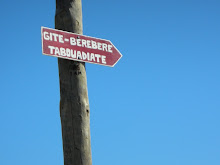In this post I will:-give a brief overview of who may and may not benefit from this tutorial
-give specific instructions and dimensions for constructing your own mold and deckle
Since starting to make paper here in Morocco almost one year ago, I've had many requests to teach fellow volunteers as well as host country nationals, and take my paper making operation on the road. This is a great medium for working with handicraft cooperatives, as well as children as part of an art/environment project. For this reason, this project has great potential for at least three of the four volunteer sectors in Morocco (small business development, environment, and youth development).
Unfortunately, beyond the Training Of Trainers (TOT) workshop I held in my home in September, 2009, and the recent TOT workshop for Fatima and Hafida, I haven't been able to do any trainings outside of my site due to a number of circumstances. Mostly the problem seems to be due to the amount of materials needed. I am more than happy to bring my mold and deckle around to other sites to share this activity, but it's just impractical to travel with all the other necessary equipment. Most volunteers underestimate the amount of work that goes into getting everything prepared to make handmade paper. This shouldn't be a project that a volunteer does on a whim or as a one time only event because of the amount of time and money investment that will need to go into it. Because the initial investment is kinda high, the longer the project continues the more worth while the investment becomes.
That said, I do not want to discourage volunteers or crafters seriously interested in paper making from pursuing this activity if it fits into a larger project that they are doing. That is in fact why I wanted to post this tutorial. I want it be replicated by others. I want people to realize that this can be a very viable project if you and your counterparts are motivated.
I don't want to overwhelm you with too much information, and will therefore split it up into separate posts.
Constructing the mold frameBelow is a diagram to illustrate how to construct the mold. It's made with four pieces of wood.
-cut two pieces of wood to 36cm x 5cm x 2cm
-cut two pieces of wood to 24cm x 5cm x 2cm
-assemble as shown in diagram below using wood screws and glue to secure the pieces instead of nails
 Constructing the deckle frame
Constructing the deckle frame
Below is a diagram to illustrate how to construct the deckle. It's made in two sections, each containing four pieces of wood which are then assembled together to make one structure of eight pieces of wood. The first structure is assembled the same way as the mold.
-cut two pieces of wood to 28cm x 3cm x 1cm
-cut two pieces of wood to 38.25 cm x 3cm x 1cm
-assemble these four pieces as shown in top of diagram below using wood screws and glue to secure the pieces instead of nails (same construction as mold)
-cut two pieces of wood to 32 cm x 1cm x 3cm
-cut two pieces of wood to 30.25 cm x 1cm x 3cm
-assemble these four pieces as shown in the middle portion of the diagram below using glue
-assemble the top section to the bottom section as seen in the bottom portion of the diagram using glue and screws or nails
*the diagram shows the deckle constructed upside down.
 Lacquer the mold and deckle
Lacquer the mold and deckleNow that you have you mold and deckle constructed you must protect it with at least 3 coats of lacquer so that water will not warp and damage it. Make sure that you let it dry thoroughly between each coat. This step can take several days.
Attach the screensAfter the mold and deckle have a few coats of lacquer and they are thoroughly dry it's time to put the screen on the mold. I used two different types of screen. The firs was a metal screen with fairly large openings, the second was a plastic screen with smaller openings. Both are common here in Morocco and can be found in any hardware store. I bought a staple gun to attach both screens to the mold. I started with the metal screen and then placed the plastic one on top. The metal screen only covers the top of the mold, where as the plastic one comes down on the sides. You don't want the screen to be too bulky on the sides of the mold or the deckle will not fit properly. However, a little space has been allotted for the screen in the dimensions and thus will make a nice snug fit.




Now you have a mold and deckle! You've just completed the first step to making paper! If any part of my directions are confusing to you, please let me know in the comments section. Or, if you use my tutorial to make a mold and deckle let me know! That's all for today, but don't despair, this tutorial will continue soon...























































